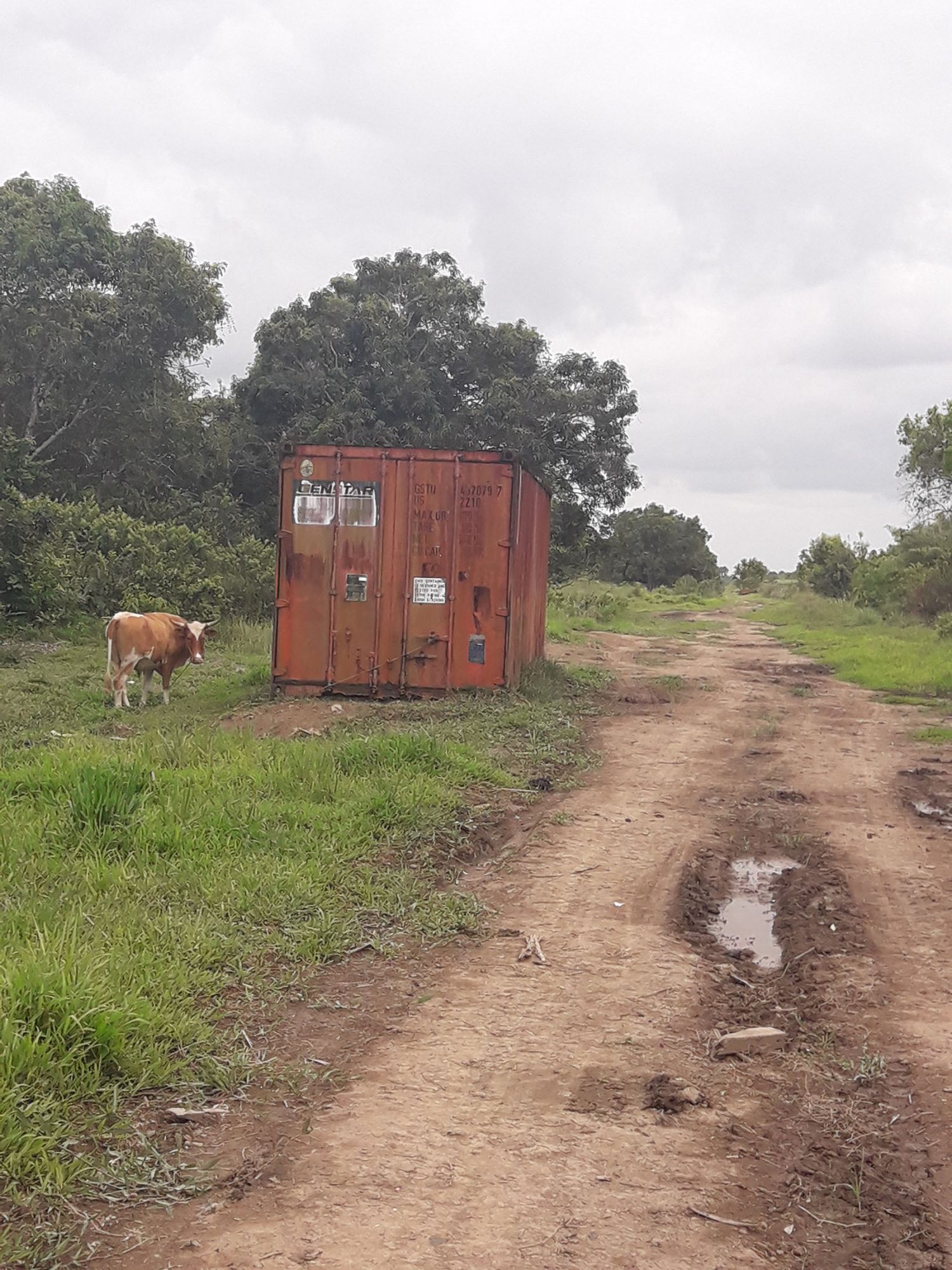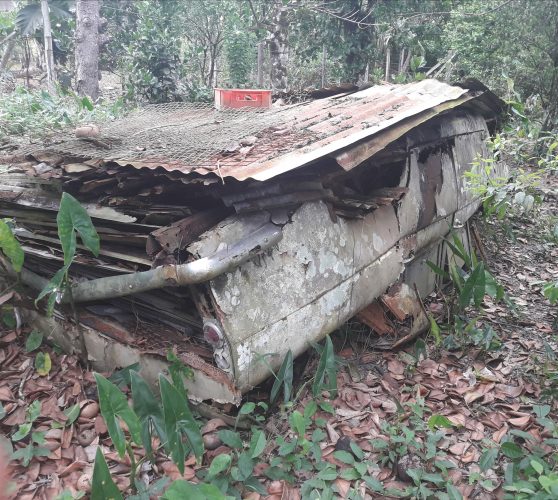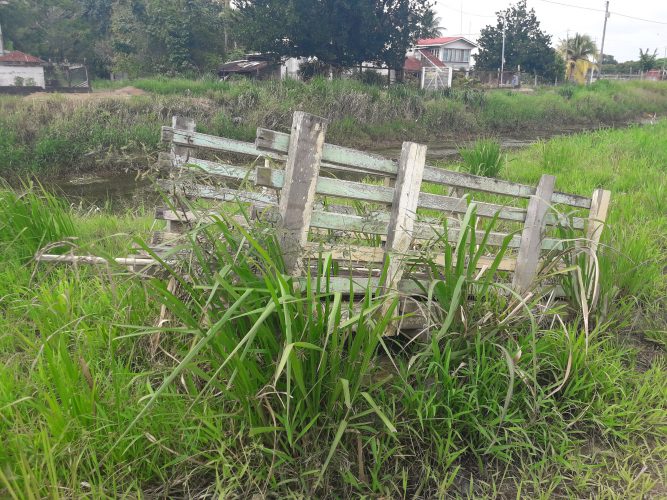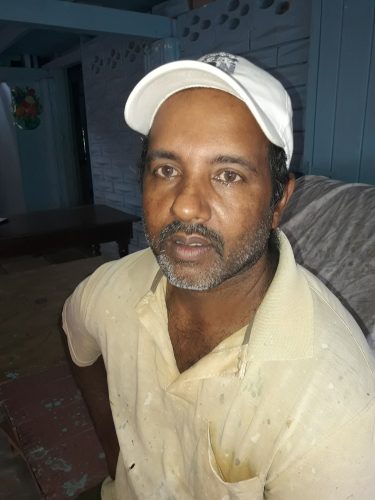Sans Souci is situated along the Canal Number One Road between Studley Park and L’Esperance and is two villages away from the Conservancy. Like most villages in the area San Souci is big in terms of measurements, however, migration over the years has left the village with fewer than 50 residents.
Right at the start of the village, one can observe many locked up houses. In many cases, there are weeds clambering over the fences and climbing right up the walls of the houses.
A huge water tank sat at the roadside. It was used by backdam workers as soon as they hopped off a cane trailer, which stopped on a dam not far away. Hurrying across a bridge, they used their hands to funnel the water into their mouths; some leaned their heads directly under the tap. A few men washed their faces and splashed water on their skin before heading home.
Dharamraj Angad and his wife were sitting down to catch their breaths having just returned from their farm.
Angad, originally from Endeavour, Canal Number One, bought his place in Sans Souci after he got married in 1972. He and his family moved there in 1979. Farming is the main economic activity and it is mostly citrus that is grown, with ground provision and cash crops on a smaller scale.
Angad’s citrus farm is a small one which he and his wife tend. He sells his crop wholesale at his residence.
“Me ah 70 years now and since abbe [he and his siblings] gat sense, ah farming. Me cut cane, clean trench, work in the interior transporting fuel and goods and do plenty other jobs,” the pensioner said.
As a youngster, he attended the McGillivray Government School. Every morning before school he got up at five to take care of the family’s cows, then after school ended for the day, made his way to the farm to continue there.
Though his life was tasked with hard work, Angad said it was easy adding that work is what you make it. “If yuh lazy, then it gon be hard. You got to be progressive. Once you progressive you will make ends meet,” he stated.
The main road to Canal Number One was made of what was termed as ‘bun rubbish’. The road is said to be seven miles long running from the Bagotville junction to the Conservancy Dam. The trek from Sans Souci to the junction is approximately six miles. Back when there was no transportation, villagers did it in about two hours or longer if they stopped to rest. Most persons chose to take their canoes or paid for a ride on one of the launches, which were specifically for carrying produce to the Stabroek Market.
After some years, Angad bought his own car; it was the Morris Oxford Series 6. A little bigger than today’s sedans, these cars sometimes carried 20 people; transportation was very difficult in those days. Angad and his wife laughed as they looked back at the way things were. The remains of his car sits on its top in his backyard rotting under aluminium sheets.
“Nowadays children happy,” Angad said, changing the topic. “Boy or girl longtime had to ketch backdam. Yuh guh to school barefoot. Children come home today and they gon sit down in front of the TV or guh deh on deh phone.”
But he said Sans Souci is peaceful, more so now owing to migration. The house next door was vacant and so were the houses on either side of Dhanshwar Mangar’s home.
Mangar was born in Sans Souci. His grandparents had bought the place more than a century ago. Mangar is a citrus farmer during the day and a security guard at McGillivray Primary School at night.
According to him, most of the citrus on Guyana’s market is grown in Canal Number One.
Sans Souci holds dear memories for Mangar. He recalled playing many games including his favourite ‘roller’ (something similar to a child’s scooter that was made of wood), and with his ‘dragline’ made of sardine tins as well as his ‘bucktop’.
He deems the residents of San Souci “peaceful and cool” and a cooperative set of people. The man further said that there has been a number of times that he went to his farm without locking up or left his weeding machine on his farm and would return to find his belongings just as he left them.
He sells his produce at the Stabroek Market or sometimes persons buy from him right at home. Last December, Mangar and other farmers suffered a blow to their crops and poultry during the heavy rainfall that led to flooding. Mangar lost more than 200 baby chicks and has since put the rearing of chickens on hold. He and the other farmers are bracing for this year’s May/June rains.
Pointing to a discarded cart at the side of the road, Mangar said they were used to fetch produce and were hauled by bulls that were trained and obedient. This mode of transport no longer exists.
He claimed that at night when he is working at the school, he would sometimes look out of his hut and see a huge ball of fire which he called a “Firerass” moving slowly across the canefields. He said asked a friend a few times to accompany him into the backdam to see what it was, but his friend for fear of his life would always decline, as it is believed to be evil. He still hopes that he would be able to find out one day.
Mahendranauth Hardyal very well known around the village as ‘Maso’ was also born and raised in Sans Souci. The house he grew up in was made from the Manicole tree bark and had aluminium sheets for a roof.
He was the youngest of seven children: four brothers and three sisters. His father worked at the Leonora Sugar Estate and his mother worked on a farm cutting rice. Later, Leonora Estate gave small farmers a loan of cane tops, roam plow, transportation of cane to the estate and would dig the drains on their farms; with every crop, they were expected to pay the estate back in installments.
Maso, on writing Common Entrance, had secured a place at Patentia Secondary School but because his family was very poor and could not afford to pay the cost of transportation, he continued attending the McGillivray Primary. According to the man he always looked forward to holidays. A month leading up to Easter and a month after would have found him and other friends making kites. Phagwah and Diwali were other anticipated holidays and he recalled spinning lit steel wool to make fireworks.
He began working at 14, having left school. He planted cassava and would work from 9 to 12 in the mornings and after returning home for lunch, hurry back to the farm to work until 3. He recalled that there were 3 launches that he would use to take produce to the Stabroek Market.
Today he is still a farmer and one of the councillors of the Neighbourhood Democratic Council (NDC). He grows pineapple, avocado, orange, tangerine and mamee. His wife sells these fruits at the Wales Market. The man said prior to the closing down of the Wales Estate, his wife would sell sometimes 7 or 8 dozen pineapples a week; nowadays she sells just 3 or 4 single pineapples in the same period. This is because many of the former sugar cane harvesters have taken up pineapple farming, resulting in a glut on he market. Pineapples are going to waste because of this, he said. To add to this, expenses are high; fertilizers cost a lot and when he does sell off, Maso said, he sometimes only breaks even.
They were badly affected by the December rains and although farmers were visited by Minister Joseph Harmon and other officials, Maso said they received mops, bottles of bleach and disinfectant but no seedlings or anything of the sort.
He further said that poor drainage is solely responsible for the flooding. Currently, the NDC cleans the secondary drains but it is the regional administration that is responsible for the cleaning of the primary drains.
Last December’s flood water, Maso said, was inches lower than the 2005 Great Flood and added that it was the villagers who came together to clean the drains themselves to get the water to run off. Maso wishes that the primary drains can be looked into as soon as possible, especially with May/June rains here already.















